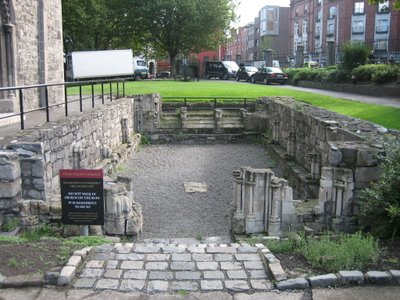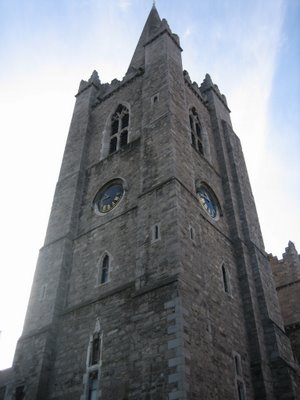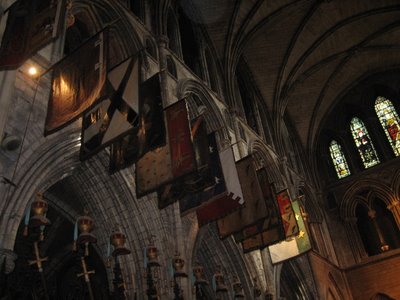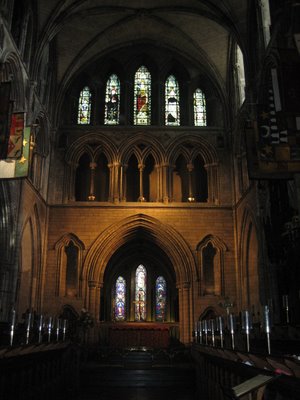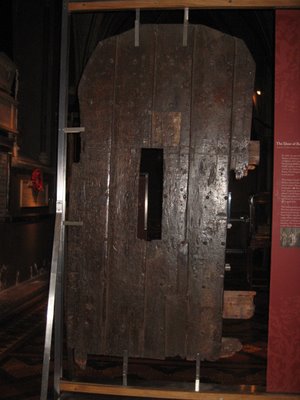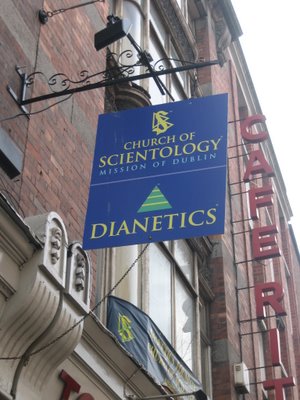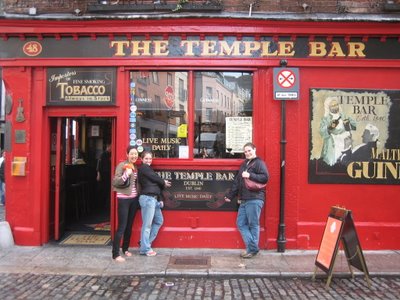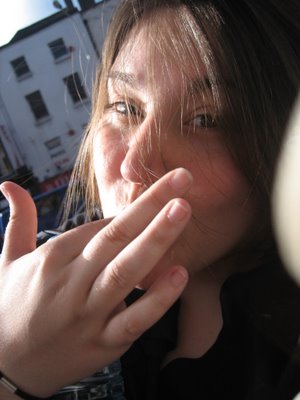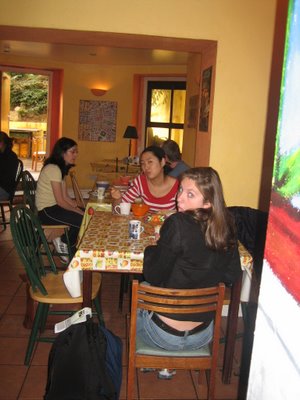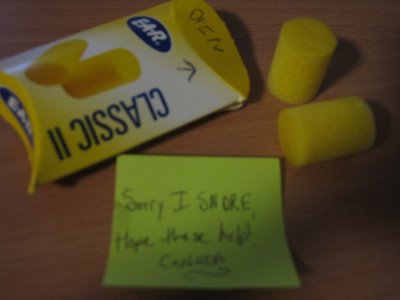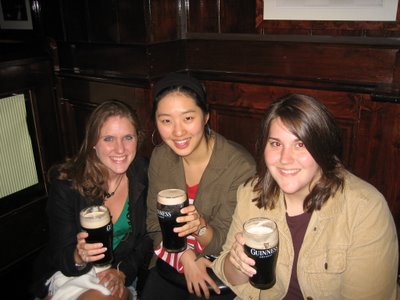 The group, minus one. In this picture, kindly provided by Whitney (the photographer), the excitement on the early morning streets of Edinburgh is tangible. Go ahead, reach out and touch it.
The group, minus one. In this picture, kindly provided by Whitney (the photographer), the excitement on the early morning streets of Edinburgh is tangible. Go ahead, reach out and touch it.[Back row, left to right: Tom, J (yes, just 'J'), Kim
Front row, left to right: Jenna, Kara, Me (in the dapper, 100% virgin Irish wool blazer I got in exchange for my immortal soul)]
 Our first stop on the tour was the Forth Rail Bridge, an engineering masterpiece from the late nineteenth century. Constructed over eight years by a workforce of fifty-thousand men, the bridge has not needed any significant structural repairs since its opening in 1890, despite shouldering the traffic of two hundred freight and commuter trains each day. The same cannot be said for the neighboring Forth Road Bridge, a suspension bridge dating from the mid-1960s, which will likely have to replaced in the next ten years due to corrosion and shoddy workmanship. At the risk of sounding like my father, they just don't make things like they used to.
Our first stop on the tour was the Forth Rail Bridge, an engineering masterpiece from the late nineteenth century. Constructed over eight years by a workforce of fifty-thousand men, the bridge has not needed any significant structural repairs since its opening in 1890, despite shouldering the traffic of two hundred freight and commuter trains each day. The same cannot be said for the neighboring Forth Road Bridge, a suspension bridge dating from the mid-1960s, which will likely have to replaced in the next ten years due to corrosion and shoddy workmanship. At the risk of sounding like my father, they just don't make things like they used to.We crossed the Forth Road Bridge and entered the Kingdom of Fife, which is not a kingdom proper, but a peninsular county on the eastern coast. Naturally, the coastlines of Fife are dotted with quaint fishing villages, such as Anstruther, seen below.
 Anstruther's seafront. The small turquoise building on the main drag was proclaimed the best fish and chip shop in the world. While we didn't sample the fried delectables, we found their homemade ice cream to be absolutely faboo.
Anstruther's seafront. The small turquoise building on the main drag was proclaimed the best fish and chip shop in the world. While we didn't sample the fried delectables, we found their homemade ice cream to be absolutely faboo. Overlooking the waters of the Firth of Forth, which opens into the North Sea. The clouds were beginning to break in the mid-morning sun.
Overlooking the waters of the Firth of Forth, which opens into the North Sea. The clouds were beginning to break in the mid-morning sun. More of the same. I've never been terribly fond of tropical beaches, but the icy, rocky shores of northern beaches have always been a favorite.
More of the same. I've never been terribly fond of tropical beaches, but the icy, rocky shores of northern beaches have always been a favorite.We spent a wee while in Anstruther before heading up to St. Andrews. As the decision to go up to St. Andrews was a spontaneous one, we hadn't done our homework with regards to the schedule of events in the birthplace of golf. Consequently, I found myself slap-bang in the middle of another flippin' golf tournament. First Dublin and the Ryder Cup, then St. Andrews and Dunhill. Will it ever end?!
 Effectively barred from both touring the greens and viewing the tournament, Team Glasgow shuffled to the beaches to re-enact one of the most iconic scenes in cinematic history.
Effectively barred from both touring the greens and viewing the tournament, Team Glasgow shuffled to the beaches to re-enact one of the most iconic scenes in cinematic history. Ladies and jellyspoons, set your peepers on West Sands Beach, the setting for the running scene in the 1981 film Chariots of Fire. Being wholly unconcerned with what the world thinks of us, we decided to pay homage to the oft-parodied clip.
Ladies and jellyspoons, set your peepers on West Sands Beach, the setting for the running scene in the 1981 film Chariots of Fire. Being wholly unconcerned with what the world thinks of us, we decided to pay homage to the oft-parodied clip. There might be an element of 'you had to be there' to this photo, but it still makes me giggle. Riotously.
There might be an element of 'you had to be there' to this photo, but it still makes me giggle. Riotously. A view of the North Sea from the shore.
A view of the North Sea from the shore.
In the tidepools on the beach, there were dozens of swans trodding along in the shallow water. Ever the curious cupcake, I decided to make friends.
 AHAHAHAHAHA! The revolution is at hand!
AHAHAHAHAHA! The revolution is at hand!Actually, swans are pretty mean animals. The one featured in the previous photo looked at me as I was preaching to my Anserinae congregation, stretched his neck to full height, and walked toward me menacingly whilst emitting a blood-chilling hiss from his ginormous beak. I'm no hero, so I quickly rejoined my group and booked it off the beach. After all, the last time someone tangled with a swan, she ended up bearing two of Zeus's children; I'm not ready for that kind of responsibility.
Obviously, I didn't come to St. Andrews with the intention of carousing with some waterfowl; instead, I came to see this:
 The ruins of St. Andrew's Cathedral. Dating from the tenth century, St. Andrew's was once the largest cathedral in Scotland. Unlike most other cathedrals in Scotland, St. Andrew's was not reduced to rubble during the Reformation, when John Knox and his Protestant followers set out to rid Scotland of every last shred of Catholicism. Rather, the cathedral fell into neglect in the sixteenth century after the central tower collapsed, bringing down the north wall of the nave with it. Afterwards, the stone from the cathedral was appropriated by villagers for building houses.
The ruins of St. Andrew's Cathedral. Dating from the tenth century, St. Andrew's was once the largest cathedral in Scotland. Unlike most other cathedrals in Scotland, St. Andrew's was not reduced to rubble during the Reformation, when John Knox and his Protestant followers set out to rid Scotland of every last shred of Catholicism. Rather, the cathedral fell into neglect in the sixteenth century after the central tower collapsed, bringing down the north wall of the nave with it. Afterwards, the stone from the cathedral was appropriated by villagers for building houses.In the nineteenth century, the cathedral ruins became a protected property and have been under the aegis of the National Trust of Scotland ever since. All that remain are the incomplete south, west, and east walls of the nave, and a few bits of the south transept.
 The remains of the west gable, as seen from what would have been the interior of the cathedral.
The remains of the west gable, as seen from what would have been the interior of the cathedral. If I'm not mistaken, this is the interior of the south transept, replete with tombs set into the turf.
If I'm not mistaken, this is the interior of the south transept, replete with tombs set into the turf. St. Rule's Tower, which probably served as the cathedral prior to the consecration of St. Andrew's in 1318 by Robert the Bruce. I purchased a token to enter the tower, hoping for some great views over the town and harbor; however, I failed to notice that I had to be back at the coach in ten minutes, else the tour would leave me several hours from home in a town with no direct bus service to Glasgow. So, if any of you readers are coming up to Scotland in the near future and have plans to see St. Andrew's Cathedral and St. Rule's Tower, come see me for an entrance token and save yourself seven bucks.
St. Rule's Tower, which probably served as the cathedral prior to the consecration of St. Andrew's in 1318 by Robert the Bruce. I purchased a token to enter the tower, hoping for some great views over the town and harbor; however, I failed to notice that I had to be back at the coach in ten minutes, else the tour would leave me several hours from home in a town with no direct bus service to Glasgow. So, if any of you readers are coming up to Scotland in the near future and have plans to see St. Andrew's Cathedral and St. Rule's Tower, come see me for an entrance token and save yourself seven bucks.

















